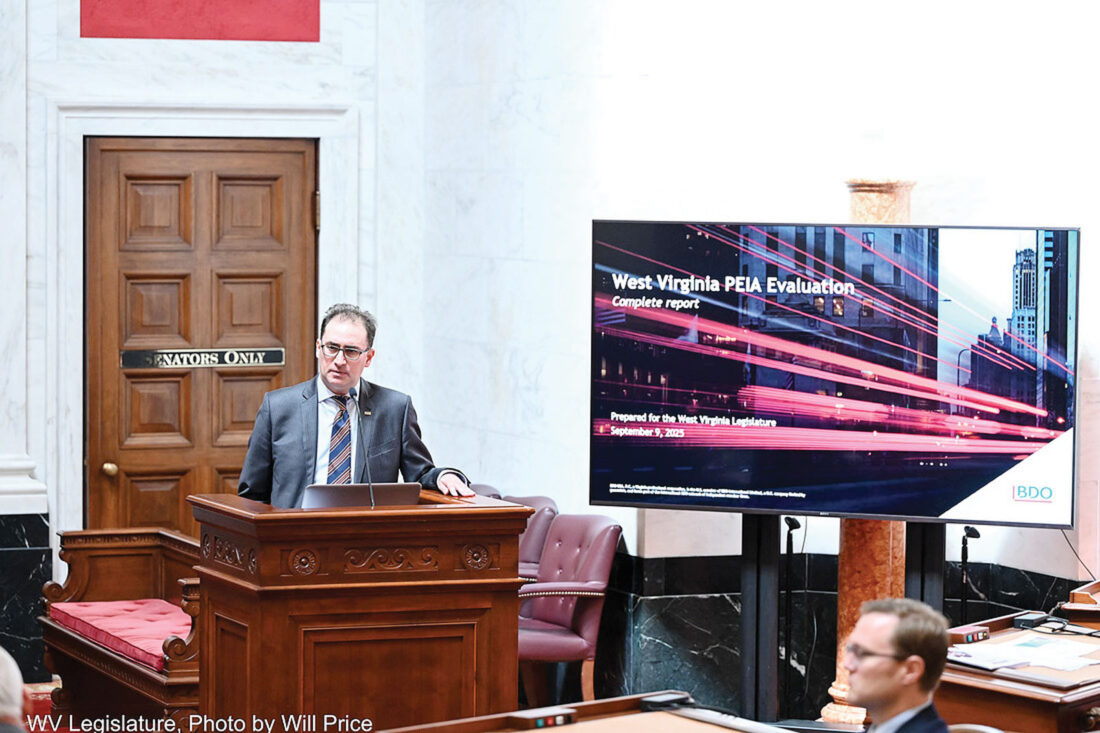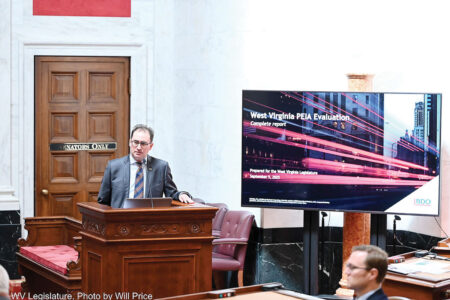Report: PEIA members satisfied with plans, but drugs driving up costs

Ben Lewis, managing director of Strategy and Innovation for BDO USA, gave lawmakers several recommendations for reducing PEIA costs Tuesday during legislative interim meetings. (Photo Courtesy/WV Legislative Photography)
CHARLESTON — No special session was called this week to address future costs for West Virginia’s public worker health care benefit program, but a new report aims to provide lawmakers with recommendations for bringing costs down, including booting county and city government participants and spouses with access to other coverage.
The Joint Standing Committee on Insurance and PEIA met Tuesday afternoon on the final day of three-day legislative interim meetings at the State Capitol Building to receive a report from Ben Lewis, managing director of Strategy and Innovation for BDO USA, regarding PEIA, the Public Employees Insurance Agency.
BDO was commissioned by the Legislature to conduct a review to evaluate the current state of PEIA, using financial analysis comparing the program to other states and to provide recommendations to the Legislature. BDO began its PEIA review six months ago.
The BDO review team interviewed 22 key individuals, including current and former PEIA leadership, union representatives, health care system executives, lawmakers, and insurance professionals. The team also used internal PEIA documents, including financial reports, actuarial studies, utilization data, vendor contracts, and data.
First established by the Legislature in 1971, PEIA provides health care coverage for all state employees, including public colleges and universities and county boards of education. It also provides coverage for participating city and county governments. As of the end of fiscal year 2025 in June, total PEIA enrollment was 74,556.
According to a review of the current state of PEIA, participants told the review team that PEIA’s plan benefits are strong, especially considering West Virginia’s salary levels. As one stakeholder said, “PEIA is noted for providing very good coverage for state employees, especially those who do not earn as much income as in the private employee market.”
PEIA’s total expenses have grown at a three-year compound annual growth rate (CAGR) of 8%, a figure that Lewis said was consistent with the national health insurance industry’s claims growth. The three largest expense categories in fiscal year 2024 were physician services at $216 million (20%), hospital services at $419 million (40%), and prescription drugs at $402 million (38%).
The largest driver of prescription drug costs and overall PEIA costs is specialty medications, such as GLP-1s (Ozempic, Wegovy, etc.) and certain autoimmune drugs.
“Prescription specialty medicine is only responsible for 1% of all the drug prescription volume, but that 1% of volume is responsible for 42% of the total pharmaceutical cost,” Lewis said. “In other words, a very small number of members are using a handful of very expensive drugs that’s responsible for 42% of the pharmaceutical expenses at the PEIA.”
Last year, the PEIA Finance Board approved premium increases for state employees beginning July 1 of 14%, a 16% increase for local government employees and a 12% increase for retirees – an increase of approximately $113 million. The Finance Board also approved an increase of 40% in out-of-pocket maximums for state and local government employees, as well as increases in co-pays. Administration fees for state and local fund employers will also increase by $2.50.
The jump in premiums is due in part to a premium freeze put in place between 2018 and 2022 by former governor Jim Justice, combined with the passage of Senate Bill 268 in 2023, which returned PEIA to an 80/20 employer-employee match for state employees beginning in fiscal year 2025, with the employee/employer match going to 70/30 for out-of-state medical care for non-contiguous out-of-state counties.
But Lewis said the state should not see a similar substantial increase in premiums, which was a correction by the market to Justice’s premium freeze and SB 268 going into effect.
“In order to catch up — to react to and manage the natural expense growth and inflation — you’ve had to dramatically increase the premiums by 14%,” Lewis said. “That has caught up to what I would describe as the market…That’s not a continuation that will last for infinity.”
Lewis gave PEIA high marks for only having a 3.1% average administrative cost compared to a national average of 11.7%. PEIA’s rate for denying health care services was also low, with only 3% of claims denied. The BDO report also cited SB 268 – which also set the reimbursement rate for all health care providers at a minimum level of 110% of what Medicare reimburses – for improving a decline of participation by health care providers.
However, the continual health care challenges of West Virginians combined with the costs of prescription drugs will continue to create costs for PEIA. A budget document prepared by the state Department of Revenue in February projected an 8.5% increase in PEIA medical costs for the current fiscal year, growing to 10% by fiscal year 2029. Prescription drug costs are projected to grow by 15.5% this fiscal year, with fiscal year 2029 drug costs projected to increase by 17%.
The BDO report included a short-list of nine recommended actions, which, if fully implemented, could reduce PEIA’s net expenses by $55 million annually (a 5% reduction). But those recommendations could have political costs attached.
The first of the nine short-list recommendations involves removing non-state employee PEIA memberships – city and county governmental employees – from PEIA. Doing so would have $1 million in net savings, but local governments would need a full year to begin seeking requests for proposals from private health insurance companies to replace PEIA coverage and provide time for transition.
“The non-state agencies have a 100% medical cost ratio. That is, they are getting good benefits and not necessarily paying as high of a premium as some of the other groups,” Lewis said. “So, in theory, if one removed the non-state employees from this pool, it would improve the medical cost ratio to 91% from 93%, which is the overall medical cost ratio at the PEIA today… that’s economically advantageous.”
Another recommendation was disenrollment of those using the spousal surcharge. The monthly spousal surcharge – approved a few years ago by the Legislature – jumped from $147 during the previous plan year to $350 for the current plan year.
“What we found through our analysis is that there was a large participation of the spousal surcharge, which suggests that the PEIA is a really good deal for couples,” Lewis said. “By either disenrolling – meaning if you have a spouse that has access to a different health insurance plan, by default, as a family, you need to go there – that would save $50 million.”
The BDO report also recommended switching from basing PEIA tiers on an employee’s salary alone to basing it on total family income, which would save the state $20 million.
Gov. Patrick Morrisey had been hinting at calling a special session, first in July then coinciding with September legislative interim meetings, to address future PEIA costs. However, consensus was not reached between the governor and lawmakers. Speaking Monday at a press conference at the State Capitol Building, Morrisey said discussions are ongoing.
“We continue to have very good conversations with the Legislature,” Morrisey said. I’m very encouraged by the discussions we’re having, and I’m still very hopeful we’re going to be able to get something done…I want to be very clear that we’re going to help save this program and protect the hardworking people that rely on PEIA. We’re not to let politics get in the way of that.”




